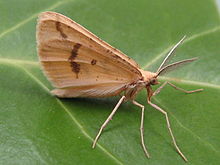Aspitates ochrearia
| Aspitates ochrearia | ||||||||||||
|---|---|---|---|---|---|---|---|---|---|---|---|---|

Aspitates ochrearia , male |
||||||||||||
| Systematics | ||||||||||||
|
||||||||||||
| Scientific name | ||||||||||||
| Aspitates ochrearia | ||||||||||||
| ( Rossi , 1794) |
Aspitates ochrearia is a butterfly fromthe Spanner family (Geometridae). The species name is derived from the Latin word ochrearius with the meaning "ocher yellow" and refers to the basic color of the butterfly.
features
butterfly
The moths reach a wingspan of 24 to 32 millimeters. The color of the forewing surface varies from amber yellow to ocher yellow to cream and shows a light brownish pollination. An outer transverse line beginning near the apex and running obliquely to the inner edge , like an inner transverse line, stands out gray-brown. A small discal spot is also gray-brown in color. The color of the upper side of the hind wing is similar to the upper side of the forewing in a slightly weakened form. The hind wing underside shows a clear dark transverse line and a center point, which shine through to the front in a softened form. The antennae of the males are combed, those of the females have short teeth.
Caterpillar
Fully grown caterpillars are dark gray with little drawing. They have two anal tips known as paraprocts .
Similar species
The moths of the single- lined dry grass tensioner ( Aspitates gilvaria ) differ in the absence of the gray-brown inner transverse line on the upper side of the forewing .
distribution and habitat
Aspitates ochrearia is widespread in southern Europe, further north and east it occurs only locally. The species is also found in North America, North Africa and parts of Asia. The main habitat are poor, dry meadows, steppes and maquis formations .
Way of life
The moths are diurnal and nocturnal. They fly in two generations, mainly in the months of March to May and July to October. At night they appear on artificial light sources . The caterpillars feed polyphagously on the leaves of a large number of different lower plants, preferably on legumes (Fabaceae).
Individual evidence
- ^ Arnold Spuler : The butterflies of Europe , Volume 2, E. Schweizerbart'sche Verlagsbuchhandlung, Stuttgart, 1910, p. 120
- ↑ a b Butterflies and their ecology ( pyrgus.de )
- ↑ flight times
Web links
- Lepiforum e. V. - Taxonomy and photos
- ukmoths.org –Yellow Belle at UKmoths
- britishlepidoptera - British Lepidoptera
- euroleps.ch - Photos Imago and caterpillar
- Aspitates ochrearia in Fauna Europaea. Retrieved May 28, 2020
